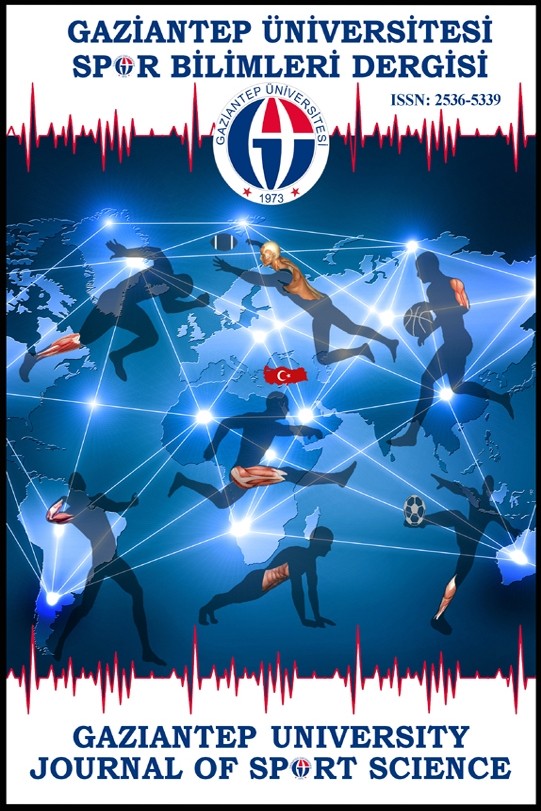Domates Suyu Takviyesinin Egzersizde HDL ve LDL Kolesterol Düzeylerine Etkilerinin İncelenmesi
Domates suyu, Aerobik egzersiz, HDL, LDL, Kolesterol
Investigation of the Effects of Tomato Juice Supplement on HDL and LDL Cholesterol Levels in Exercise
Tomato juice, Aerobic exercise, HDL, LDL, Cholesterol,
___
- Agarwal, S., Rao, A.V. (1998). Tomato lycopene and low density lipoprotein oxidation: a human dietary intervention study. Lipids. 33(10), 981-984.
- Carroll, M.D., Kit, B.K., Lacher, D.A. (2012). Total and high-density lipoprotein cholesterol in adults: National Health and Nutrition Examination Survey, 2009–2010. NCHS Data Brief. 92, 1–8.
- Fuhrman, B., Elis, A., Aviram, M. (1997). Hypocholesterolemic effect of lycopene and beta-carotene is related to suppression of cholesterol synthesis and augmentation of LDL receptor activity in macrophages. Biochemical and Biophysical Research Communications. 233, 658–662.
- Hadley, C.W., Clinton, S.K., Schwartz, S.J. (2003). The consumption of processed tomato products enhances plasma lycopene concentrations in association with a reduced lipoprotein sensitivity to oxidative damage. J Nutr. 133, 727–732.
- Hininger, I.A., Meyer-Wenger, A., Moser, U., Wright, A., Southon, S., Thurnham, D., Roussel, A.M. (2001). No significant effects of lutein, lycopene or β-carotene supplementation on biological markers of oxidative stress and LDL oxidizability in healthy adult subjects. Journal of the American College of Nutrition. 20(3), 232-238.
- Karvonen, M.J, Kentala, E, Mustala, O. (1957). The effects of training on heart rate: a longitudinal study. Ann Med Exp Biol Fenn. 35(3), 307-15.
- Kim, D.J., Kim, J.H. (2020). Effects of Lower Body Muscle Exercise on Blood Lipids and Homocystein. Medico Legal Update. 20(1), 2014-2019.
- Kodama, S., Tanaka, S., Saito, K., Shu, M., Sone, Y., Onitake, F., Ohashi, Y. (2007). Effect of aerobic exercise training on serum levels of high-density lipoprotein cholesterol: a meta-analysis. Archives of internal medicine. 167(10), 999-1008.
- Li, Y.F., Chang, Y.Y., Huang, H.C., Wu, Y.C., Yang, M.D., Chao, P.M. (2015). Tomato juice supplementation in young women reduces inflammatory adipokine levels independently of body fat reduction. Nutrition (Burbank, Los Angeles County, Calif). 31(5), 691–696.
- Nassef, Y., Lee, K.J., Nfor, O.N., Tantoh, D.M., Chou, M.C., Liaw, Y.P. (2019). The impact of aerobic exercise and badminton on HDL cholesterol levels in adult Taiwanese. Nutrients. 11(3), 515.
- Negri, R., Trinchese, G., Carbone, F., Caprio, M.G., Stanzione, G., di Scala, C., et al. (2020). Randomised Clinical Trial: Calorie Restriction Regimen with Tomato Juice Supplementation Ameliorates Oxidative Stress and Preserves a Proper Immune Surveillance Modulating Mitochondrial Bioenergetics of T-Lymphocytes in Obese Children Affected by Non-Alcoholic Fatty Liver Disease (NAFLD). Journal of Clinical Medicine. 9(1), 141.
- Odai, T., Terauchi, M., Okamoto, D., Hirose, M., Miyasaka, N. (2019). Unsalted tomato juice intake improves blood pressure and serum low‐density lipoprotein cholesterol level in local Japanese residents at risk of cardiovascular disease. Food Science Nutrition. 7, 2271–2279.
- O'Meara, J.G., Kardia, S.L., Armon, J.J., Brown, C.A., Boerwinkle, E., Turner, S.T. (2004). Ethnic and sex differences in the prevalence, treatment, and control of dyslipidemia among hypertensive adults in the GENOA study. Archives of internal medicine. 164(12), 1313-1318.
- Patnode, C.D., Evans, C.V., Senger, C.A., Redmond, N., Lin, J.S. (2017). Behavioral counseling to promote a healthful diet and physical activity for cardiovascular disease prevention in adults without known cardiovascular disease risk factors: updated evidence report and systematic review for the US Preventive Services Task Force. Jama. 318(2), 175-193.
- Ried, K. (2011). Protective effect of lycopene on serum cholesterol and blood pressure: meta-analyses of intervention trials. Maturitas. 68, 299–310.
- Rossi, F.E., Fortaleza, A.C., Neves, L.M., Buonani, C., Picolo, M.R., Diniz, T.A., et al. (2016). Combined training (aerobic plus strength) potentiates a reduction in body fat but demonstrates no difference on the lipid profile in postmenopausal women when compared with aerobic training with a similar training load. The Journal of Strength & Conditioning Research. 30(1), 226-234.
- Sarzynski, M.A., Ruiz-Ramie, J.J., Barber, J.L., Slentz, C.A., Apolzan, J.W., McGarrah, R.W., Oda, M.N. (2018). Effects of increasing exercise intensity and dose on multiple measures of HDL (high-density lipoprotein) function. Arteriosclerosis, thrombosis, and vascular biology. 38(4), 943-952.
- Silaste, M.L, Alfthan, G, Aro A, Kesäniemi, Y.A, Hörkkö, S. (2007). Tomato juice decreases LDL cholesterol levels and increases LDL resistance to oxidation. British Journal of Nutrition. 98, 1251–1258.
- Tseng, M.L., Ho, C.C., Chen, S.C., Huang, Y.C., Lai, C.H., Liaw, Y.P. (2013). A simple method for increasing levels of high-density lipoprotein cholesterol: a pilot study of combination aerobic-and resistance-exercise training. International journal of sport nutrition and exercise metabolism. 23(3), 271-281.
- ISSN: 2536-5339
- Başlangıç: 2016
- Yayıncı: Gaziantep Üniversitesi
Domates Suyu Takviyesinin Egzersizde HDL ve LDL Kolesterol Düzeylerine Etkilerinin İncelenmesi
Ragıp PALA, Nezihe ŞENGÜN, Leyla Sultan GÜR, Eyyüp YILDIRIM
Yusuf Bahadır DOĞRU, İdil SAYIMER, Cem ÇETİN, Fatih KOÇ
Berna CAN, Zekihan HAZAR, Sefa KURT
Tenis Oyuncularında Core Egzersizleri Tenis Performansını Etkiler Mi?
Yasemin ARI, Filiz Fatma ÇOLAKOĞLU
Türkiye’de Badminton Sporuyla İlgili Yayınlanan Bilimsel Makale ve Tezlerin İncelenmesi
Yahya DOĞAR, Mehmet AKARSU, Talha SERT
Farklı Branşlardaki Sporcuların Kollajen Tip V gen (COL5A1) rs12722 Polimorfizmlerinin Dağılımı
Celal BULGAY, Canan SERCAN DOĞAN, Gözdem KARAPINAR, Tolga POLAT, Ebru CETIN, Korkut ULUCAN
Elit Seviyedeki Bireysel Kadın Sporcuların Duygusal Zekâ Düzeylerinin İncelenmesi
Demet ÖZTÜRK ÇELİK, Osman YILMAZ, İbrahim ŞAHİN, Mehmet BESLER
